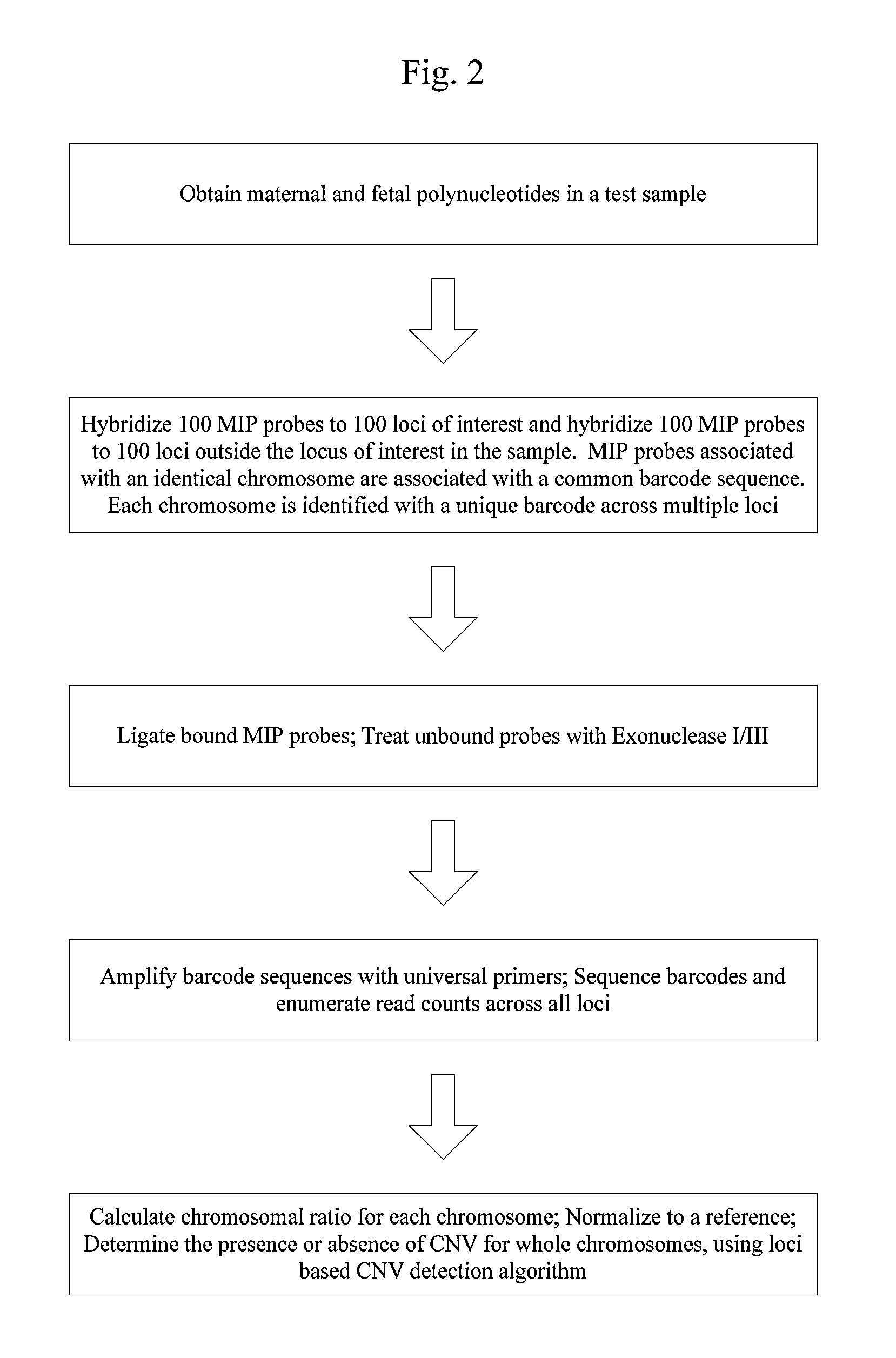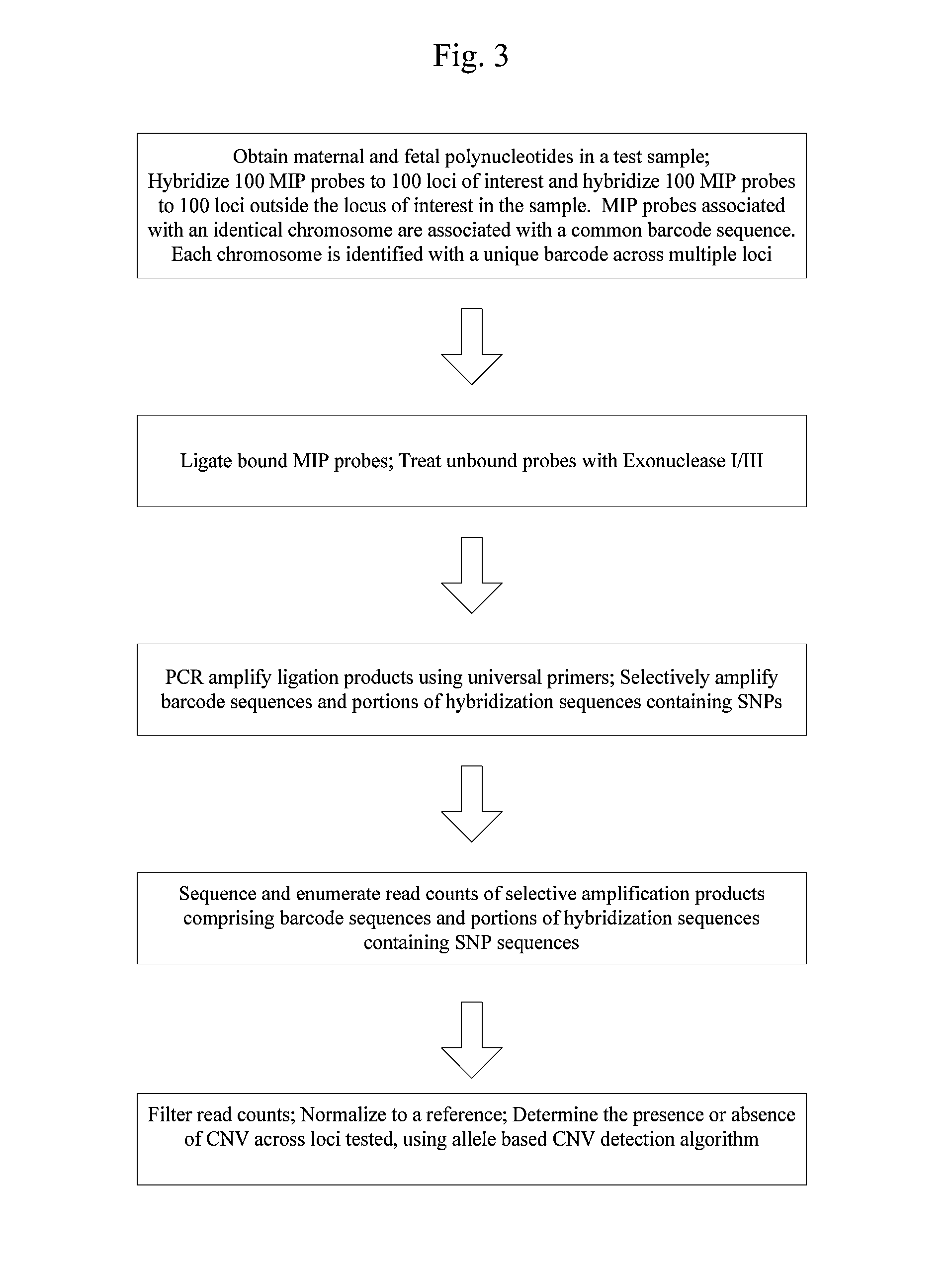Systems and methods for prenatal genetic analysis
a genetic analysis and prenatal technology, applied in the field of systems and methods for prenatal genetic analysis, can solve the problems of large amount of genomic sequence, adverse health consequences, and large amount of genetic alterations in a genome, and achieve the effects of low efficiency process, long time-consuming and labor-intensive, and high cos
- Summary
- Abstract
- Description
- Claims
- Application Information
AI Technical Summary
Benefits of technology
Problems solved by technology
Method used
Image
Examples
example 1
General Experimental Parameters for MIP Probe Ligation and Amplification
[0241]1. Probe design
2. Create a pooled stock at 100 attomole / ul / probe (60 million molecules / ul / probe)
3. Sample extraction (i.e isolation of ctDNA)[0242]A. Collect blood in Cell-Free DNA BCT using commercial kit[0243]B. For optimal results, include a Proteinase K treatment step (≧30 mAU / ml digest) at 60° C. in the presence of chaotropic salts for 1 hour when extracting cell-free DNA and for 2 hours when extracting cellular genomic DNA.
4. Assay
[0244]1. Combine:[0245]a. Extracted cfDNA[0246]b. with 1 ul of probe stock[0247]c. in 1× ampligase buffer (Epicentre Technologies[0248]d. to a volume of 7.8 ul[0249]2. Thermocycler:[0250]a. The annealing reaction mixture was heated to 95° C. for 5 min.[0251]b. Then, the temperature was dropped one degree at a time for 1 min at each temperature, until 65° C. was reached and[0252]c. Held at 65° C. overnight.[0253]3. Add:[0254]a. 1 U ampligase enzyme (Epicentre Technologies)[0...
example 2
Detection of Trisomy 21
[0274]Peripheral blood samples are collected from a pregnant woman in her first or second trimester of pregnancy. Collected samples are centrifuged to obtain cell-free plasma. Cell-free DNA is the extracted from the plasma fraction using QiAmp DNA Blood Mini Kit (Qiagen) according to the manufacturer's instructions. Approximately 5 ng of DNA is obtained from 15 ml of blood.
[0275]MIP probe sets, designed for loci of interest in chromosome 21, are used to test the sample for detection of putative Trisomy 21. Loci of interest are selected throughout the chromosome, in regions of both arms and centromeric regions. Specific probe sequences are selected using optimization algorithms such as ROSO to select optimal probes and probe sets for hybridization. Selection criteria include site selectivity, minimization of cross reactivity with loci outside of chromosome 21, probe length, salt tolerance in hybridization reactions, minimization of secondary structures in the p...
example 3
Multi-CNV Test for Chromosomes 13, 18, 21, X, and Y
[0282]Using a similar experimental protocol strategy as described in Example 2, a multi chromosome test for CNV may be performed. Additionally, sub-chromosomal regions containing CNVs may also be detected. MIP probes, with similar characteristics to those as described in Example 2 are designed to hybridize various loci across Chromosome 13, 18, 21, X and Y. Reference probes are designed for the remaining chromosomes, Chromosomes 1-20 and 22. Individual probe sets are assigned a unique barcode sequence to resolve sequence counts for individual loci in regions of chromosomes. In addition, MIP probes are designed such that universal amplification sites flank unique barcode sequences that are additionally flanked by Illumina compatible adapter sequences. This design eliminates the need for an additional amplification step to incorporate adapter sequences for sequencing as described in Example 2.
[0283]Using similar biochemical and molecu...
PUM
| Property | Measurement | Unit |
|---|---|---|
| Fraction | aaaaa | aaaaa |
| Affinity | aaaaa | aaaaa |
| Degradation properties | aaaaa | aaaaa |
Abstract
Description
Claims
Application Information
 Login to View More
Login to View More - R&D
- Intellectual Property
- Life Sciences
- Materials
- Tech Scout
- Unparalleled Data Quality
- Higher Quality Content
- 60% Fewer Hallucinations
Browse by: Latest US Patents, China's latest patents, Technical Efficacy Thesaurus, Application Domain, Technology Topic, Popular Technical Reports.
© 2025 PatSnap. All rights reserved.Legal|Privacy policy|Modern Slavery Act Transparency Statement|Sitemap|About US| Contact US: help@patsnap.com



